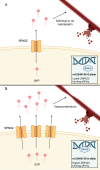Sphingosine-1-phosphate Signalling in Aneurysmal Subarachnoid Haemorrhage: Basic Science to Clinical Translation
- PMID: 36749550
- PMCID: PMC10891271
- DOI: 10.1007/s12975-023-01133-9
Sphingosine-1-phosphate Signalling in Aneurysmal Subarachnoid Haemorrhage: Basic Science to Clinical Translation
Abstract
Sphingosine-1-phosphate (S1P) is generated intracellularly and, when transported to the extracellular compartment, predominantly signals through S1P receptors. The S1P signalling pathway has been implicated in the pathophysiology of neurological injury following aneurysmal subarachnoid haemorrhage (aSAH). In this review, we bring together all the available data regarding the role of S1P in neurological injury following aSAH. There is agreement in the literature that S1P increases in the cerebrospinal fluid following aSAH and leads to cerebral artery vasospasm. On the other hand, the role of S1P in the parenchyma is less clear cut, with different studies arguing for beneficial and deleterious effects. A parsimonious interpretation of this apparently conflicting data is presented. We discuss the potential of S1P receptor modulators, in clinical use for multiple sclerosis, to be repurposed for aSAH. Finally, we highlight the gaps in our knowledge of S1P signalling in humans, the clinical challenges of targeting the S1P pathway after aSAH and other research priorities.
Keywords: Outcome; Sphingosine-1-phosphate; Sphingosine-1-phosphate receptor modulators; Subarachnoid haemorrhage.
© 2023. The Author(s).
Conflict of interest statement
The authors declare no competing interests.
Figures




References
Publication types
MeSH terms
Substances
LinkOut - more resources
Full Text Sources
